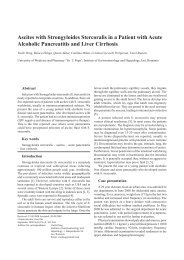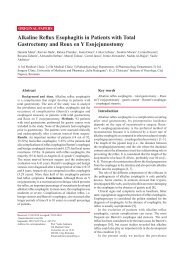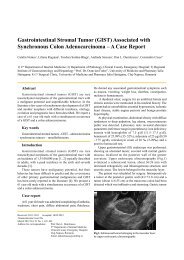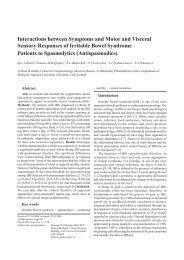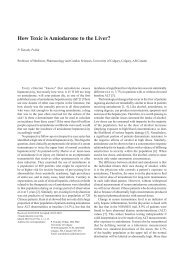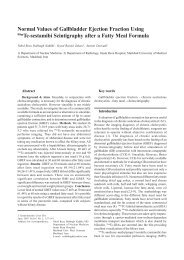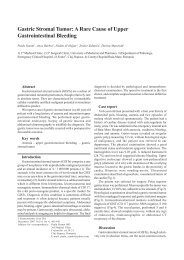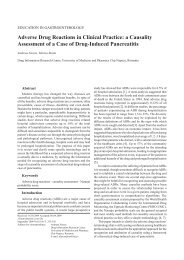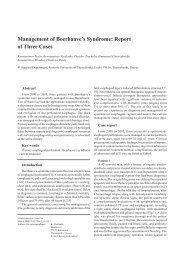Glycogen Storage Disease Type I - Journal of Gastrointestinal and ...
Glycogen Storage Disease Type I - Journal of Gastrointestinal and ...
Glycogen Storage Disease Type I - Journal of Gastrointestinal and ...
Create successful ePaper yourself
Turn your PDF publications into a flip-book with our unique Google optimized e-Paper software.
50<br />
<strong>and</strong> Ib in those two cases associated with frequent bacterial<br />
infections <strong>and</strong> neutropenia (cases 4 <strong>and</strong> 6) (1,21,22). In these<br />
two cases, although they had no suggestive symptoms, we<br />
performed also colonoscopy <strong>and</strong> colonic mucous biopsies<br />
to identify the eventual changes consistent with inflammatory<br />
bowel disease that is <strong>of</strong>ten associated with glycogen<br />
storage disease type Ib (6,7,22). We found no such changes.<br />
Therapeutic approach<br />
The mainstay <strong>of</strong> therapy in all cases consisted <strong>of</strong> dietary<br />
measures including a pattern <strong>of</strong> frequent carbohydrate<br />
feedings; administration <strong>of</strong> 2 g/kg <strong>of</strong> uncooked cornstarch<br />
suspensions (1,8,9,20) every 6 hours was effective in<br />
avoiding hypoglycemia symptoms in all children. However,<br />
during follow-up, in spite <strong>of</strong> this measure, there were still<br />
low glycemic values in the morning, but no accompanying<br />
symptoms.<br />
Data about the development <strong>of</strong> premature atherosclerosis<br />
in young adult GSD I patients are very scarce. Even though<br />
in familial hypercholesterolemia or familial combined<br />
hyperlipidemia, a comparable degree <strong>of</strong> hyperlipidemia is<br />
associated with cardiovascular morbidity <strong>and</strong> mortality at<br />
early age, studies showed that GSD type Ia is not associated<br />
with premature atherosclerosis, despite the longst<strong>and</strong>ing<br />
dyslipidaemia <strong>and</strong> microalbuminuria (10). Little is known<br />
about possible vascular protective mechanisms against the<br />
dyslipidaemia in GSD Ia. The diminished platelet aggregation<br />
(11) can be only partly protective (12). Recently, a decreased<br />
susceptibility <strong>of</strong> in vitro oxidation <strong>of</strong> VLDL cholesterol has<br />
been found (13). The renal deleterious effects <strong>of</strong><br />
dyslipidaemia are, however, an argument for lipid-lowering<br />
measures, including drug treatment (14,15,20). We<br />
considered it prudent to advise our patients to avoid high<br />
lipid intake, <strong>and</strong> we recommended omega-3 fatty acids<br />
supplements (fish oil) for their effect <strong>of</strong> decreasing<br />
triglycerides <strong>and</strong> VLDL levels in hypertriglyceridemic<br />
subjects, with a concomitant increase in HDL. Omega-3 fatty<br />
acids lower plasma triglycerides by inhibiting VLDL <strong>and</strong><br />
apolipoprotein B-100 (16) synthesis, <strong>and</strong> in conjunction with<br />
transcription factors, target the genes governing cellular<br />
triglyceride production <strong>and</strong> those activating oxidation <strong>of</strong><br />
excess fatty acids in the liver. Inhibition <strong>of</strong> fatty acid<br />
synthesis <strong>and</strong> increased fatty acid catabolism reduce the<br />
amount <strong>of</strong> substrate available for triglyceride production<br />
(17). We also recommended dietary restrictions on fructose<br />
<strong>and</strong> galactose <strong>and</strong> supplemented the diet with calcium <strong>and</strong><br />
multivitamins (1).<br />
All patients received treatment with ursodeoxycholic<br />
acid (15 mg/kg body weight) for its hepatoprotective effects<br />
<strong>and</strong> its intervention in cholesterol metabolism.<br />
Those patients with type Ib GSD received also broad<br />
spectrum antibiotics, <strong>and</strong> one <strong>of</strong> them received granulocyte<br />
colony-stimulating factor (GCSF) 5 μg/kg twice per week for<br />
a period <strong>of</strong> two years, <strong>and</strong> the median neutrophil counts<br />
increased significantly to normal values <strong>and</strong> simultaneously<br />
there was a slight decrease in median leukocyte <strong>and</strong> platelet<br />
Moraru et al<br />
counts, <strong>and</strong> the number <strong>and</strong> severity <strong>of</strong> infections decreased.<br />
As a complication <strong>of</strong> the treatment, a mild splenomegaly<br />
occurred.<br />
Evolution during follow-up<br />
The patients were followed-up in our clinic for a period<br />
<strong>of</strong> 1 to 5 years. The follow-up parameters were clinical (the<br />
amount <strong>of</strong> catch-up growth under appropriate carbohydrate<br />
supplementation, the liver span, psychological evaluation),<br />
biological (neutrophil count, glycemic pr<strong>of</strong>ile, transaminase<br />
levels, lipid pr<strong>of</strong>ile, uric acid levels, renal function<br />
parameters), imaging (for early detection <strong>of</strong> focal hepatic<br />
lesions <strong>and</strong> renal changes).<br />
One <strong>of</strong> the four patients with short stature had a<br />
satisfactory growth rate, reaching normal values for age<br />
after two years <strong>of</strong> treatment. The other three patients<br />
remained under normal values for age. Cases 1 <strong>and</strong> 2 that<br />
showed normal values <strong>of</strong> the anthropometric measurements<br />
for age at diagnosis also had a satisfactory growth rate.<br />
Liver span decreased in four cases by 10-15 % <strong>and</strong> increased<br />
by 10-15% in the other two cases. There were no signs <strong>of</strong><br />
brain damage or any deterioration in cognitive functions or<br />
delay in psychomotor achievements.<br />
Despite the dietary measures, there was poor control <strong>of</strong><br />
the glycemic values in cases 2 <strong>and</strong> 3, with frequent moderate<br />
hypoglycemia during the night <strong>and</strong> in the morning<br />
accompanied by sweating, tremor, irritability/apathy. In the<br />
other 4 cases there was good glycemia control, with rare<br />
episodes <strong>of</strong> hypoglycemia accompanying acute diseases<br />
with low oral intake that required intravenous glucose<br />
support <strong>and</strong> prompt metabolic intervention until resolution.<br />
Transaminase levels remained moderately to mildly<br />
increased, with the exception <strong>of</strong> case 3 that maintained moderate<br />
to high levels for a period <strong>of</strong> one year <strong>of</strong> follow-up<br />
(Fig3).<br />
Fig.3 Transaminase values during follow-up.<br />
Cholesterol <strong>and</strong> triglyceride values normalized in case 1<br />
<strong>and</strong> remained slightly to moderately increased in the other 4<br />
cases.<br />
Uric acid was high after 3 <strong>and</strong> 4 years, respectively, in<br />
cases 3 <strong>and</strong> 2, <strong>and</strong> normal in all the other cases. We used<br />
allopurinol 10 mg/kg/day divided in three doses.




